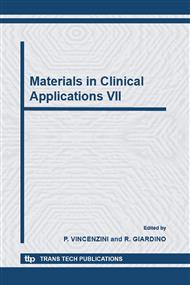p.165
p.171
p.181
p.189
p.197
p.203
p.212
p.222
p.227
Immobilization of Chitosan on the Plasma-Activated Poly-L-Lactic Acid Film Surface Using Evaporated Acrylic Acid as the Intermediate
Abstract:
Nerve bridging is to suture a biomaterial-made conduit and to overpass the damaged nerve end to end with microsurgery. Poly L-lactide (PLLA) is an excellent biomaterial that has biocompatible, biodegradable and good mechanical properties; it is thus potential to be engineered as nerve conduits and manufactured as scaffolds for nerve tissue replacement. On the other hand, chitosan provides cell affinity and considerably promotes nerves regeneration. This study is to apply plasma processing for PLLA film modification, graft the plasma-modified film with vaporized acrylic acid (AAc) monomers and then immobilize chitosan by amide bonding on the pAAc-grafted surface. This work using plasma-activation and subsequent evaporation of AAc greatly avoids PLLA thermal cracking and remaining the PLLA film in good mechanical properties. Surface morphologies are evaluated by Nano Focus. Electron Spectroscopy for Chemical Analysis (ESCA) and Attenuated Total Reflectance Fourier-Transform Infrared Spectroscopy (ATR-FTIR) are respectively employed for determining elements’ functionalities and chemical structures. Moreover, biological functionalities of the chitosan-immobilized PLLA films are thereafter assessed by antibacterial test and in vitro fibroblastic cell growth assay. The result exhibits that chitosan is immobilized on the modified PLLA films, which is plasma-activated subsequent to the evaporation of AAc. The process does not induce thermal cracking. In vitro fibroblastic cell growth assay on the chitosan-immobilized PLLA films has demonstrated that fibroblast cells on the surface become circular in shape. It decreases cell growth rate and the development of scar tissues, which may thereafter promote the effect of nerve repairing.
Info:
Periodical:
Pages:
197-202
Citation:
Online since:
October 2006
Authors:
Price:
Сopyright:
© 2006 Trans Tech Publications Ltd. All Rights Reserved
Share:
Citation:


